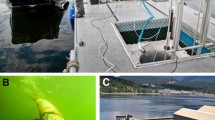Abstract
Since terrestrial mammals usually have continuous access to air while exercising, most investigations on the oxygen demands of exercise have looked at the physiological or biochemical limits to oxygen transport and utilization. Recently there has also been a substantial interest in exercise at altitudes where oxygen supplies start to become limiting (Sutton et al. 1982). However, there have been only a few studies of mammalian exercise under the extreme conditions of complete inaccessibility to oxygen: marine mammals swim, hunt, and work underwater without access to air — they must carry their oxygen supplies with them while diving. It was quickly realized that diving mammals possess two major adaptations that allow such underwater work: increased oxygen storage capacity relative to terrestrial mammals and the ability to utilize a “diving reflex” — a physiological response that shunts the oxygen-enriched blood away from the peripheral organs towards the primary aerobic tissues such as the heart, lung, and brain (Irving 1939; Scholander 1940). In recent years it has been found that this reflex is actually a response of variable nature and tends to be maximized under laboratory diving conditions and minimal during natural diving within the animals aerobic dive limits (Hill et al. 1984; Kooyman et al. 1980, 1983). However, as more information on natural diving becomes available another interesting controversy has arisen: the requirements for diving, which include bradycardia, reduced metabolism and some peripheral vasoconstriction, conflict with the standard physiological adjustments seen in aerobically exercising terrestrial mammals.
Access this chapter
Tax calculation will be finalised at checkout
Purchases are for personal use only
Preview
Unable to display preview. Download preview PDF.
Similar content being viewed by others
References
Blix AS (1976) Metabolic consequences of submersion asphyxia in mammals and birds. Biochem Soc Symp 41: 169–178
Butler PJ, Jones DR (1982) Respiratory and cardiovascular control during diving in birds and mammals. J Exp Biol 100: 195–221
Castellini MA, Somero GN (1981) Buffering capacity of vertebrate muscle: correlations with potentials for anaerobic function. J Comp Physiol 143: 191–198
Castellini MA, Somero GN, Kooyman GL (1981) Glycolytic enzyme activities in tissues of marine and terrestrial mammals. Physiol Zool 54 (2): 242–252
Castellini MA, Murphy BJ, Fedak M, Ronald K, Gofton N, Hochachka PW (1985) Potentially conflicting metabolic demands of diving and exercise in seals. J App Physiol 58 (2): 392–399
Davis RW (1983) Lactate and glucose metabolism in the resting and diving harbor seal (Phoca vitulîna). J Comp Physiol 153: 275–288
Davis RW, Castellini MA, Kooyman GL, Maue R (1983a) Rénal glomerular filtration rate and hepatic blood flow during voluntary diving in Weddell seals. Am J Physiol 245: R743–R748
Davis RW, Williams TW, Kooyman GL (1983b) Swimming metabolism in yearling and adult harbor seals (Phoca vitulina). Abstract. Fifth biennial conférence on the biology of marine mammals. Boston
Fedak MA, Kanishwer J, Lapennas G (1983) Patterns of breathing and heart rate in relation to energy requirements of swimming and diving seals. Abstract. Fifth biennial conference on the biology of marine mammals. Boston
Friedman JJ, Selkurt EE (1966) Circulation in specific organs. In: Selkurt EE (ed) Physiology. Little, Brown, Boston
Hill RD, Schneider RC, Liggins GC, Hochachka PW, Schuette AH, Zapol WM (1983) Microprocessor controlled recording of bradycardia during free diving in the antarctic Weddell seal. Abstract Fed Proc 42 (3): 470
Hill RD, Zapol WM, Liggins GC, Schneider RC, Schuette AH, Hochachka PW (1984) Metabolite biochemistry of the Weddell seal diving at sea. Am J Physiol (Regulatory) (in press)
Hochachka PW (1981) Brain, lung, and heart functions during diving and recovery. Science 212: 509–514
Hochachka PW, Storey KB (1975) Metabolic conséquences of diving in animals and man. Science 187: 613–621
Irving L (1939) Respiration in diving mammals. Physiol Rev 19: 112–134
Kanwisher JW, Gabrielson G, Kanwisher N (1981) Free and forced diving in birds. Science 211: 717–719
Kooyman GL (1981) Weddell seal-consummate diver, Ist edn. Cambridge, New York
Kooyman GL (1982) How marine mammals dive. In: Taylor CR, Johansen K, Bolis L (eds) A companion to animal physiology. Cambridge, London, p 151
Kooyman GL, Kerem DH, Campbell WB, Wright JJ (1973) Pulmonary gas exchange in freely diving Weddell seals, (Leptonychotes weddelii). Respir Physiol 17: 283–290
Kooyman GL, Wahrenbrock EA, Castellini MA, Davis RW, Sinnett EE (1980) Aerobic and anaerobic metabolism during voluntary diving in Weddell seals: evidence of preferred pathways from blood chemistry and behavior. J Comp Physiol 138: 335–346
Kooyman GL, Castellini MA, Davis RW, Maue R (1983) Aerobic diving limits of immature Weddell seals. J Comp Physiol 151: 171–174
Lenfant C, Johansen K, Torrance SD (1970) Gas transport and oxygen storage capacity in some pinnipeds and the sea otter. Respir Physiol 9: 277–286
Lin YC, Matsuura DT, Whittow GC (1972) Respiratory variation of heart rate in the California sealion. Am J Physiol 222: 260–264
Murphy BJ, Zapol WM, Hochachka PW (1980) Metabolic activities of heart, lung, and brain during diving and recovery in the Weddell seal. J Appl Physiol 48 (4): 596–605
Scholander PF (1940) Experimental investigatory function in diving mammals and birds. Hvalradets Skr 22: 1–131
Sutton JR, Jones NL, Houston CS (ed) (1982) Hypoxia: Man at altitude. Thieme-Stratton, New York 226
Zapol WM, Liggins GC, Schneider RC, Qvist J, Snider M, Creasy T, Hochachka PW (1979) Regional blood flow during simulated diving in the conscious Weddell seal. J Appl Physiol 47: 968–973
Author information
Authors and Affiliations
Editor information
Editors and Affiliations
Rights and permissions
Copyright information
© 1985 Springer-Verlag Berlin Heidelberg
About this paper
Cite this paper
Castellini, M.A. (1985). Closed Systems: Resolving Potentially Conflicting Demands of Diving and Exercise in Marine Mammals. In: Gilles, R. (eds) Circulation, Respiration, and Metabolism. Proceedings in Life Sciences. Springer, Berlin, Heidelberg. https://doi.org/10.1007/978-3-642-70610-3_16
Download citation
DOI: https://doi.org/10.1007/978-3-642-70610-3_16
Publisher Name: Springer, Berlin, Heidelberg
Print ISBN: 978-3-642-70612-7
Online ISBN: 978-3-642-70610-3
eBook Packages: Springer Book Archive




